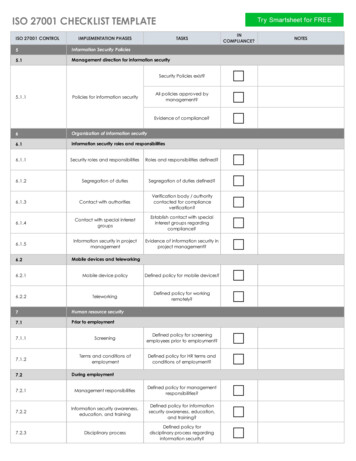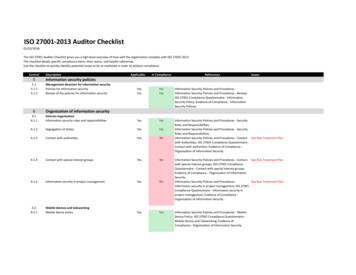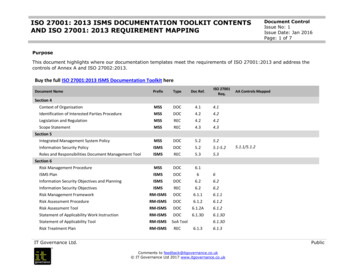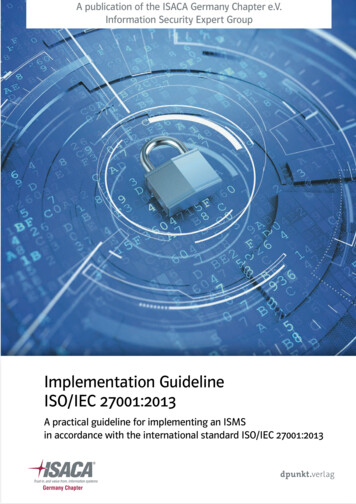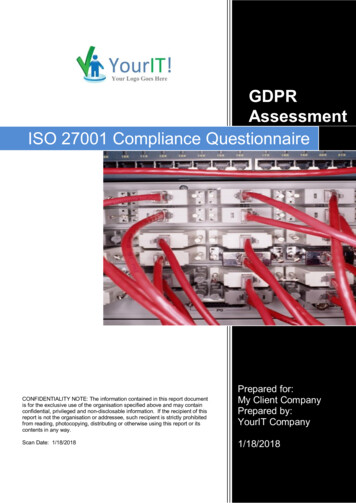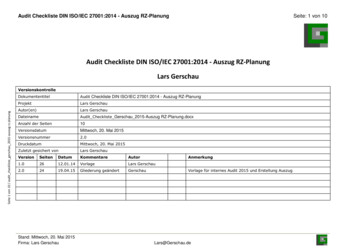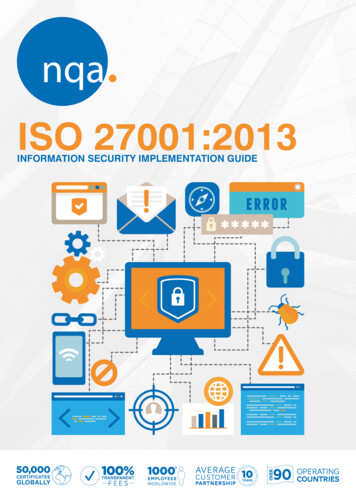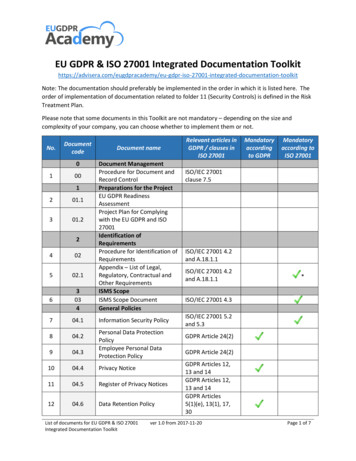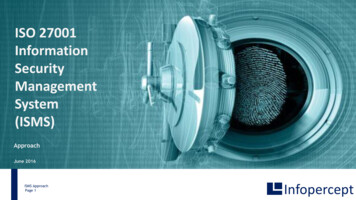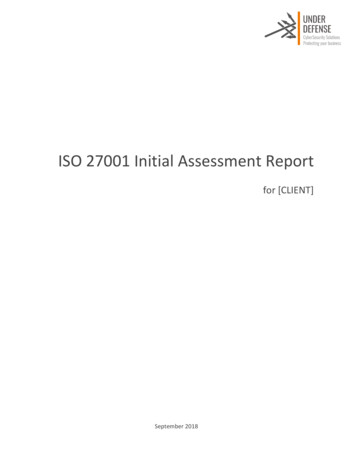
Transcription
ISO 27001 Initial Assessment Reportfor [CLIENT]September 2018
TABLE OF CONTENTSTable of contents1Executive Summary3Our methodology4Key stakeholders interviewed4Maturity Level for each clause of ISO 270015Conclusions6RoadMap7Recommendations – ISMS activities10Plan stage11Do stage14Check stage15Act stage16Recommendations – Annex A controls17A.5 Information Security Policies17A.6 Organisation of Information Security18A.7 Human resources security20A.8 Asset management22Inventory tools to install (as a recommendation )A.9 Access controlPassword managers to install (as a recommendation )222426A.10 Cryptography28A.11 Physical and environmental security29A.12 Operations security31Antivirus tools to install (as a recommendation )32Vulnerability management tools to install (as a recommendation )35A.13 Communications security36A.14 System acquisition, development and maintenance38A.15 Supplier relationships41A.16 Information security incident management43A.17 Information security aspects of business continuity management45A.18 Compliance47Summary[CLIENT] Initial Assessment Report50Page 1 of 49
EXECUTIVE SUMMARY[CLIENT] has requested that UnderDefense, as an independent and trusted Cyber Security partner,conducts an assessment and analysis of the current state of the information security program of theorganization and its compliance with ISO 27001:2013 standard. ISO 27001 (ISO 27001:2013) is aninternational standard for the implementation of a best practice Information Security ManagementSystem (ISMS). ISO 27001 accreditation requires an organisation to bring information security underexplicit management control.The objective of the assessment was to document the current state of the ISMS and Annex A controls at[CLIENT] sites, understand the state, and recommend actions needed to achieve the required state toprepare for ISO/IEC 27001 certification.[CLIENT] Initial Assessment ReportPage 2 of 49
Our methodologyOur methodology is based on the interview and practical evaluation with the key stakeholders, reviewingtechnical documentation and checking readiness to conduct ISO/IEC 27001 certification. All the findingsare mapped on ISO/IEC 27001:2013 standard (see below). R ating provided in form of Maturity Levelmatrix and Radar chart.Key stakeholders interviewedThe first important step of our assessment was the interview with the key stakeholders and employees tocollect information and check on practice the current control set and the risks that knowledge keepersobserve in the organization. The following table represents a list of individuals who took part in theinterview. The respondents shared the information regarding information security in their organization,presented current controls of information security in their departments and answered questions fromISO 27001 checklists regarding processes, finance, systems, infrastructure, business processes, policies,growth plans, endpoint security, operating systems, access controls, valuable assets, risks, etc.Position in the companyRespondentDirector of OperationsIT DirectorHead of CIS (corp. information systems)Managing DirectorHR DepartmentAccounting DepartmentHR DirectorDevOpsPMO DirectorQA DirectorHead of Recruiting[CLIENT] Initial Assessment ReportPage 3 of 49
Maturity Level for each clause of ISO 27001To illustrate the conformity to ISO 27001, we have assigned a level of coverage based upon the legendbelow.UD Observation Ranking(Conforms or Major andMinor non-conformity)(Conformity Rating)MajorMinorConformsObservationCannot be assessedDescriptionSignificant improvement needed (major non-conformities and/orsignificant number of minor non-conformities)Minor to moderate improvement needed (minor non-conformitiesand/or observations)Certification readyInformational comment not impacting certification readinessThe control cannot be assessed as it has not been neither designed orimplemented and it's applicability to [CLIENT] ISMS is not definedNone of these shortfalls are insurmountable, but addressing them will require management commitmentto establish, implement, maintain and improve a comprehensive ISMS.[CLIENT] Initial Assessment ReportPage 4 of 49
ConclusionsRadar chart below provides a graphical summary of the assessment outcome. The chart describes thecurrent maturity level of each ISO/IEC 27001:2013 Annex A control. Each maturity level corresponds tonumeric level on the chart:- Level 1 - Major non-conformity,- Level 2 - Minor non-conformity,- Level 3 - ConformsFigure 1. Graphical representation of each maturity level.[CLIENT] Initial Assessment ReportPage 5 of 49
RoadMap[CLIENT] needs to assign roles and responsibilities, to handle all actions related to the analysis of thenon-conformity, execution of improvements and controls implementation to achieve the acceptablestate for certification.The table below shows ISO 27001:2013 controls ordered and prioritized by severity of Maturity Levels.The table represents step by step guide to start executing improvements on minor non-conformityclauses and proceed with major non-conformity. It is highly recommended to follow the order, controls,which marked as Conforms, represent what’s already in place and working well, minor non-conformitiescan be resolved by one-time activities(e.g. waterfall methodology), major non-conformities requiresiterative, team-based approach, in order complete all activities, resolve issues effectively and in time.The table can be treated as a project plan that contents 3 Stages, as presented in the table below, whichrepresent required steps for successful transition and compliance.Сontrol#Maturity LevelRecommendations - Appendix AA.7.1 Prior to employmentConformsA.17.2 RedundanciesConforms1Stage 11.1A.6.1 Internal OrganisationMinor non-conformity1.2.A.9.1 Business requirements for access controlMinor non-conformity1.3.A.9.2 User access managementMinor non-conformity1.4.A.11.1 Secure areasMinor non-conformity1.5A.12.1 Operational procedures and responsibilitiesMinor non-conformity1.6A.12.3 BackupMinor non-conformity1.7A.13.1 Network security managementMinor non-conformity1.8A.14.2 Security in development and support processesMinor non-conformity1.9A.15.1 Information security in supplier relationshipsMinor non-conformity1.10A.17.1 Information security continuityMinor non-conformity[CLIENT] Initial Assessment ReportPage 6 of 49
1.11A.18.1 Compliance with legal and contractual requirements2Stage 22.1A.6.2 Mobile devices and teleworkingMajor non-conformity2.2A.7.2 During employmentMajor non-conformity2.3A.8.1 Responsibility for assetsMajor non-conformity2.4A.8.2 Information ClassificationMajor non-conformity2.5A.8.3 Media handlingMajor non-conformity2.6A.9.3 User responsibilitiesMajor non-conformity2.7A.9.4 System and application access controlMajor non-conformity2.8A.10.1 Cryptographic controlsMajor non-conformity2.9A.11.2 EquipmentMajor non-conformity2.10A.12.2 Protection from malwareMajor non-conformity2.11A.12.4 Control of operational softwareMajor non-conformity2.12A.12.5 Controls against malwareMajor non-conformity2.13A.12.6 Technical vulnerability managementMajor non-conformity2.14A.13.2 Information transferMajor non-conformity2.15A.14.1 Security requirements of information systemsMajor non-conformity2.16A.16.1 Management of information security incidents andimprovementsMajor non-conformity2.17A.18.2 Information security reviewsMajor non-conformity2.18A.5.1 Management direction for information securityMajor non-conformityMinor non-conformityCannot be assessedA.12.7 Information systems audit considerationsCannot be assessedA.14.3 Test dataCannot be assessed[CLIENT] Initial Assessment ReportPage 7 of 49
A.15.2 Supplier service delivery managementCannot be assessedRecommendations – ISMS activities3Stage 33.1Scope DefinitionMajor non-conformity3.2Risk Assessment Approach and ExecutionMajor non-conformity3.3Treatment of Risks, including Statement of ApplicabilityMajor non-conformity3.4Risk Treatment PlanMajor non-conformity3.5Monitoring, Review of the ISMS & Effectiveness of ControlsMajor non-conformity3.6ISMS Improvement including Corrective & Preventive ActionsMajor non-conformity[CLIENT] Initial Assessment ReportPage 8 of 49
Recommendations – ISMS activitiesThe tables on the subsequent pages include recommendations for improvements needed to achieve thelevel of maturity required for ISO 27001 certification (Required target state).The actions are divided into the Plan, Do, Check and Act phases of the [CLIENT]’s Information SecurityManagement System (ISMS). The Plan-Do-Check-Act (PDCA) cycle is an iterative process and with eachiteration the organization has the opportunity to (re-)define the scope of its Information SecurityManagement System, (re-)define risks, (re-)select controls and adjust or create processes, policies andguidelines.All activities listed within this section must be completed in advance of the initial certification audit.Note, each stage of the PDCA cycle requires approach documents to be created (i.e. policy/ proceduredocuments). It is up to the discretion of management to determine if these documents should becreated during the Plan stage or if they should be developed during the respective stages in which thedocuments will be used.These recommendations represent typical activities needed to implement and operate an ISMS and toprepare for ISO 27001 certification. [CLIENT] management will need to ultimately decide what actions toundertake within their environment.[CLIENT] Initial Assessment ReportPage 9 of 49
Plan stageScope DefinitionShort descriptionUD ObservationsThe ISMS scope should be defined in terms of characteristics of the business,the organization, its locations, assets and technologies. ISMS scope is not documented and approved by management. Thescope contains the list of the areas, locations, assets, and technologiesof the organization controlled by the ISMS. Exclusions from the scopeare not documented and justified.UD ObservationRanking Major non-conformity Document ISMS scope including the list of the areas, locations, assets,and technologies of the organization.Document all exclusions from ISMS scope (e.g., sales representativeoffices, software developed by client-facing project teams, etc.), andjustification for exclusion from scope.Review and re-approve ISMS scope document with managementannually or in cases if significant changes to the environment occuroutside of the annual review cycle (e.g. regulatory changes, inclusionof new locations, etc.). RecommendationsDocumentsreviewed N/aRisk Assessment Approach and ExecutionShort descriptionA Risk Assessment approach should be created for the organization. UD Observations [CLIENT] Initial Assessment ReportThe organization has not developed and documented a comprehensiveRisk Management Framework that describes all steps and relevantmethods required to be carried out in terms of risk assessment process,including:- Asset Identification- Threat Identification- Vulnerability Identification- Control Analysis- Likelihood Determination- Impact Analysis- Risk Determination- Control Recommendations- Results DocumentationThe organization has not defined and documented the lists of assetsthat are included within ISMS scope.Page 10 of 49
UD ObservationRankingMajor non-conformity Recommendations DocumentsreviewedCreate Risk Management Framework document contains risk levelsmatrix which is based on a 5-level scale (Very Low to Very High), andprovides the instructions for risk level determination.Adjust Risk Assessment Framework so that it includes the criteria foraccepting risk and identifying the acceptable level of (e.g. at what levelcan risk automatically be accepted and under what circumstances).Approval should be obtained from high-level management for thedecision to accept residual risks, and authorization obtained for theactual operation of the ISMS.Review the documents containing the lists of assets and define a singlecomprehensive list of assets along with asset owners while consideringabove mentioned recommendation.N/aTreatment of Risks, including Statement of ApplicabilityShort descriptionUD ObservationsUD ObservationRankingSelect the method for treating risks identified and obtain managementapproval for the proposed residual risks. A Statement of Applicability (SOA) document is not available at[CLIENT]. For the external certification Statement of Applicability is a keyevidence of the steps taken between risk assessment andimplementation of appropriate controls.Major non-conformity Recommendations [CLIENT] Initial Assessment ReportThe SOA document must be derived from the output of the riskassessment/ risk treatment plan and, if ISO 27001 compliance is to beachieved, must directly relate the selected controls back to the originalrisks they are intended to mitigate.For each risk, the options for treatment are must be evaluated (e.g.applying controls, accepting, avoiding or transferring risks) and actionsare performed based on the selected option. Management approval isneeded for each situation where risks are accepted.A Statement of Applicability identifies whether each of the controlsdefined within Annex A of the ISO 27001 (or other relevant controls)standard will be applied or not based on the Risk Treatment Plan.Page 11 of 49
DocumentsreviewedN/a[CLIENT] Initial Assessment ReportPage 12 of 49
Do stageRisk Treatment PlanShort descriptionUD ObservationsUD ObservationRankingFormulate and implement a Risk Treatment Plan that outlines the managementaction, resources, responsibilities and priorities needed to achieve the plan. The organization has not documented the requirements for RiskTreatment Plan creation and has not created Risk Treatment Plantemplate.Major non-conformity Develop a comprehensive Risk Treatment Plan that would include:- Appropriate management action. Management should agree withthe Risk Treatment Plan and approve any risk acceptance
[CLIENT] Initial Assessment Report Page 10 of 49 . UD Observation Ranking Major non-conformity Recommendations Create Risk Management Framework document contains risk levels matrix which is based on a 5-level scale (Very Low to Very High), and provides the instructions for risk level determination. Adjust Risk Assessment Framework so that it includes the criteria for accepting risk and .



